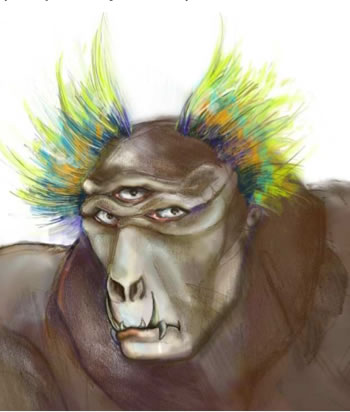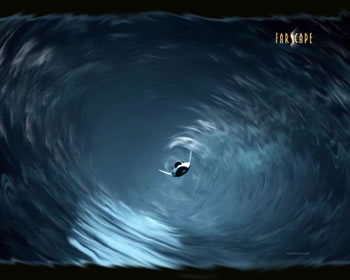Science Fiction
Dictionary
A B C D E F G H I J K L M N O P Q R S T U V W X Y Z
Fall Into Black Hole Video

A video showing what happens if you fall into a black hole has been created by researchers Andrew Hamilton and Gavin Polhemus of the University of Colorado. If you fell into a black hole, what would it look like? Could you see beyond the event horizon? Take a look inside a black hole.
(Video shows inside of black hole)
Obviously, this is a CGI realization of the work done in predicting the characteristics of spacetime inside the event horizon of a Schwarzchild black hole. Sorry, nobody's sent in a camera! Here's an excerpt from the paper backing the simulation.
The view as the observer approaches the central singularity is of particular interest because, according to ideas arising from “observer complementarity,” points in opposite directions along the observer’s past light cone are at “the edge of locality,” where standard flat-space quantum-field-theory commutation rules may beat the brink of failure. Near the singularity, the observer’s view is aberrated by the diverging tidal force into a horizontal plane. The view in the horizontal plane is highly blue shifted, but all directions other than horizontal appear highly red shifted. We argue that the affine distance provides a canonical measure of distance along a light ray from emitter to observer. Since the affine distance is not directly measurable by the observer, we also consider perceptual distances, and argue that the trinocular distance (binocular distance is inadequate) provides an estimate of affine distance that would allow tree-leaping apes to survive in highly curved spacetime.
Considerately, the authors provide us with a nice sketch of the three-eyed inhabitants of a highly curved spacetime.

(Black Hole inhabitant with trinocular vision [pdf])
One must assume that acute inhabitants [shown above] of highly curved spacetime would evolve three eyes, trinocular vision, to process the ellipsoidal wavefront into a best distance, one that allows them to leap from tree to tree with the least incidence of death....the mean of the reciprocal polar and azimuthal binocular distances agrees well with the affine distance even well off-axis where the wavefront is quite non-spherical. This suggests that a good strategy for the brains of three-eyed apes would be to infer a distance from the mean of the reciprocal binocular distances, that is, from the trace of the wavefront curvature matrix.
Can you see outside a black hole?
“When an observer outside the horizon observes the horizon of a black hole,” the researchers say, “they are actually observing the outgoing horizon. When they subsequently fall through the horizon, they do not fall through the horizon they were looking at, the outgoing horizon; rather, they fall through the ingoing horizon, which was invisible to them until they actually passed through it. Once inside the horizon, the in-faller sees both outgoing and ingoing horizons.”
One good sf reference for this situation (falling into a black hole) comes from the Farscape series. John Crichton is an IASA astronaut working on an experimental project dubbed "Farscape". During a test flight above Earth's orbit, a wormhole suddenly appears, hurling John to a distant part of the universe.

(Falling into a wormhole)
What's your favorite falling into a black hole scenario?
I particularly enjoyed this video; for the past two Saturdays, I've been treated to Saturday Morning Physics lectures at the University of Michigan campus on the subject of black holes. Professor Doug Richstone, Lawrence H. Aller Professor of Astronomy, presented an excellent talk on Supermassive Black Holes and the Evolution of Galaxies. Professor Marta Volonteri contributed a fascinating talk on Black Holes Along Cosmic Time.
From MIT's Technology Review; see also the paper The edge of locality: visualizing a black hole from the inside [pdf]. Also, take a look at the resources at this University of Colorado site Journey into a Schwarzschild black hole for more details and extra videos. Thanks to Moira for the tip and reference.
Scroll down for more stories in the same category. (Story submitted 4/2/2009)
Follow this kind of news @Technovelgy.| Email | RSS | Blog It | Stumble | del.icio.us | Digg | Reddit |
Would
you like to contribute a story tip?
It's easy:
Get the URL of the story, and the related sf author, and add
it here.
Comment/Join discussion ( 0 )
Related News Stories - (" Space Tech ")
Will Space Stations Have Large Interior Spaces Again?
'They filed clumsily into the battleroom, like children in a swimming pool for the first time, clinging to the handholds along the side.' - Orson Scott Card, 1985.
Reflect Orbital Offers 'Sunlight on Demand' And Light Pollution
'I don't have to tell you about the seven two-mile-diameter orbital mirrors...'
Chrysalis Generation Ship to Alpha Centauri
'This was their world, their planet —
this swift-traveling, yet seemingly moveless vessel.' - Nat Schachner, 1934
The First Space Warship For Space Force
'Each of the electrical ships carried about twenty men...' - Garrett P. Serviss, 1898.
Technovelgy (that's tech-novel-gee!) is devoted to the creative science inventions and ideas of sf authors. Look for the Invention Category that interests you, the Glossary, the Invention Timeline, or see what's New.
Science Fiction
Timeline
1600-1899
1900-1939
1940's 1950's
1960's 1970's
1980's 1990's
2000's 2010's
Current News
The Zapata Air Scooter Would Be Great In A Science Fiction Story
'Betty's slapdash style.'
Thermostabilized Wet Meat Product (NASA Prototype)
There are no orbiting Michelin stars. Yet.
Could Crystal Batteries Generate Power For Centuries?
'Power could be compressed thus into an inch-square cube of what looked like blue-white ice'
India Ponders Always-On Smartphone Location Tracking
'It is necessary... for your own protection.'
Amazon Will Send You Heinlein's Knockdown Cabin
'It's so light that you can set it up in five minutes by yourself...'
Is It Time To Forbid Human Driving?
'Heavy penalties... were to be applied to any one found driving manually-controlled machines.'
Replace The Smartphone With A Connected Edge Node For AI Inference
'Buy a Little Dingbat... electropen, wrist watch, pocketphone, pocket radio, billfold ... all in one.'
Artificial Skin For Robots Is Coming Right Along
'... an elastic, tinted material that had all the feel and appearance of human flesh and epidermis.'
Robot Guard Dog On Duty
I might also be thinking of K-9 from Doctor Who.
Wearable Artificial Fabric Muscles
'It is remarkable that the long leverages of their machines are in most cases actuated by a sort of sham musculature...'
BrainBridge Concept Transplant Of Human Head Proposed
'Briquet’s head seemed to think that to find and attach a new body to her head was as easy as to fit and sew a new dress.'
Google's Nano Banana Pro Presents Handwritten Math Solutions
'...copy was turned out in a charming and entirely feminine handwriting.'
Edible Meat-Like Fungus Like Barbara Hambly's Slunch?
'It was almost unheard of for slunch to spread that fast...'
Sunday Robotics 'Memo' Bot Has Unique Training Glove
'He then started hand movements of definite pattern...'
Woman Marries Computer, Vonnegut's Dream Comes True
'Men are made of protoplasm... Lasts forever.'
Natural Gait With Prosthetic Connected To Nervous System
'The leg was to function, in a way, as a servo-mechanism operated by Larry’s brain...'
